Tang dynasty Ceramics at Sotheby's New York, 11 september 2019
Lot 687. A blue-splashed pottery jar, Tang dynasty (618-907). Height 7 5/8 in., 19.4 cm. Estimate 4,000 — 6,000 USD. Courtesy Sotheby's.
of slightly compressed ovoid form, the rounded sides tapering to a short splayed foot, and rising to an everted rolled rim, the buff pinkish body covered by a thin layer of white slip around the neck and sides, flecked with irregular splashes of vibrant cobalt blue glaze cascading in painterly drips from the rim, beneath a pale straw glaze stopping just above the foot revealing the pinkish-buff body.
Provenance: Collection of Kate Sturges Buckingham (1858-1937).
Gifted to the Art Institute of Chicago, Chicago, in memory of her sister Lucy Maud Buckingham (1870-1920) in 1924 (acc. no. 1924.291).
Lot 688. A small sancai-glazed pottery 'Mandarin duck' dish, Tang dynasty (618-907). Height 7 5/8 in., 19.4 cm. Estimate 4,000 — 6,000 USD. Courtesy Sotheby's.
the gently flaring sides rising from a flat base to an everted rim, the interior with a molded symmetrical design of two ducks each against a stylized lotus leaf and enclosed within a beaded roundel, the details picked out in blue, amber and cream glazes on a cream-colored ground.
Provenance: Collection of Kate Sturges Buckingham (1858-1937).
Gifted to the Art Institute of Chicago, Chicago, in memory of her sister Lucy Maud Buckingham (1870-1920) in 1928 (acc. no. 1928.140).
Lot 689. A blue-glazed pottery jar, Tang dynasty (618-907). Height 8 1/4 in., 21 cm. Estimate 8,000 — 12,000 USD. Courtesy Sotheby's.
of slightly compressed globular form tapering to a flat base and rising to rounded shoulders surmounted by a short neck and everted rim, generously covered with dark blue glaze applied in layered, broad splashes stopping unevenly at an unglazed base revealing the pinkish buff body, the interior with a thin pale yellow glaze.
Provenance: Collection of Kate Sturges Buckingham (1858-1937).
Gifted to the Art Institute of Chicago, Chicago, in memory of her sister Lucy Maud Buckingham (1870-1920) in 1928 (acc. no. 1928.249).
Lot 690. A sancai pottery jar, Tang dynasty (618-907). Height 7 5/8 in., 19.4 cm. Estimate 20,000 — 30,000 USD. Courtesy Sotheby's.
the shouldered ovoid body tapering towards a slightly spreading base and surmounted by a short neck with lipped rim, liberally splashed with a resist pattern of cascading layers of merging rivulets of green and ocher on a white ground, the glaze stopping unevenly above the foot, the interior with a thin pale yellow glaze.
Provenance: Collection of Kate Sturges Buckingham (1858-1937).
Gifted to the Art Institute of Chicago, Chicago, in memory of her sister Lucy Maud Buckingham (1870-1920) in 1926 (acc. no. 1926.1591).
Lot 707. A molded sancai and blue-glazed cup, Tang dynasty (618-907). Height 7 5/8 in., 19.4 cm. Estimate 10,000 — 15,000 USD. Courtesy Sotheby's.
the shallow rounded sides rising to a straight rim, the exterior molded two staggered rows of florets beneath the rim and the underside with a central stylized flowerhead encircled by eight double-rings all splashed with blue, amber and cream in a dappled pattern, the interior with alternating streaks of cobalt blue, amber and cream and three small spur marks.
Provenance: Collection of Janis H. Palmer (1917-1984).
Gifted to the Art Institute of Chicago, Chicago, in 1975 (acc. no. 1975.648-1).
Lot 708. A sancai and blue-glazed basin, Tang dynasty (618-907). Diameter 9 1/4 in., 23.5 cm. Estimate 8,000 — 12,000 USD. Courtesy Sotheby's.
the interior neatly impressed with an eight-petaled floral central medallion encircling a smaller floret, all picked-out in blue, amber and straw glazes, the cavetto splashed with a blue, white and amber chevron pattern, the exterior amber-colored with the glaze stopping unevenly above the unglazed base.
Provenance: Collection of Rose Movius Palmer (1909-2003).
Gifted to the Art Institute of Chicago, Chicago, in 1976 (acc. no. 1976.538).
Lot 709. A sancai and blue-glazed tripod dish, Tang dynasty (618-907). Diameter 11 1/4 in., 28.6 cm. Estimate 10,000 — 15,000 USD. Courtesy Sotheby's.
of circular section, the shallow sides flaring to an everted rim all supported on three cabriole feet, crisply impressed on the interior with a central roundel of a goose in flight amid stylized clouds encircled by two staggered rows of lush, undulating lotus leaves, all picked out in green, amber, and blue glazes on a pale straw-glazed ground.
Provenance: Collection of Rose Movius Palmer (1909-2003).
Gifted to the Art Institute of Chicago, Chicago, in 1976 (acc. no. 1976.534).
Lot 733. A rare sancai and blue-glazed quatrfoil dish, Tang dynasty (618-907). Width 8 1/2 in., 21.6 cm. Estimate 10,000 — 20,000 USD. Courtesy Sotheby's.
formed from four radiating ruyi heads, each cupped and lobed and supported on a foliate scroll foot, finely decorated to the interior with elegantly contrasting swathes of bright cobalt blue and pale straw glazes, the exterior amber-glazed.
Provenance: Collection of Russell M. Tyson (1867-1963).
Gifted to the Art Institute of Chicago, Chicago, in 1951 (acc. no. 1951.305).
Lot 734. A rare sancai-glazed candle stand, Tang dynasty (618-907). Height 10 5/8 in., 27 cm. Estimate 20,000 — 30,000 USD. Courtesy Sotheby's.
the cylindrical candle holder centering a circular drip pan raised on a ridged columnar support above a larger drip pan, all raised on a flared foot, covered overall with amber, green and cream glaze in vertically-oriented splashes.
Provenance: Collection of Russell M. Tyson (1867-1963).
Gifted to the Art Institute of Chicago, Chicago, in 1951 (acc. no. 1951.306).
A similar glazed candlestick in the Gulbenkian Museum of Oriental Art, University of Durham, and formerly in the Macdonald Collection, is illustrated by William Watson, Tang and Liao Ceramics, London, 1984, pl. 42. Another stand of the same form but primarily blue and amber-glazed, is in the Palace Museum, Beijing and illustrated in The Complete Collection of Treasures of the Palace Museum, Porcelain of the Jin and Tang Dynasties, 1996, Hong Kong, pl. 207. A pair of the same form and decoration was sold at Christie's New York, 20th September 2005, lot 194. For a bronze example of this form see the lamp attributed to the Six Dynasties, sold in these rooms 6th December 1983, lot 21.
Lot 736. A large painted pottery figure of a guardian, Tang dynasty (618-907). Height 31 1/2 in., 80 cm. Estimate 15,000 — 20,000 USD. Courtesy Sotheby's.
modeled standing on a crescent-shaped plinth, the figure slightly contrapposto, with one arm raised, the other lowered and with a clenched fist, the head raised in assertive attitude bearing a fierce expression beneath a helmet with upturned brim, wearing a high-collared, close-fitting armored tunic with animal-mask sleeve caps, a breastplate fastened with buckled straps, the pleated under-robe gathering at the base revealing pointed boot tips, traces of red, white and black pigment.
Provenance: Collection of Russell M. Tyson (1867-1963).
Gifted to the Art Institute of Chicago, Chicago, in 1964 (acc. no. 1964.901).
Lot 737. A large amber-glazed pottery figure of a prancing horse, Tang dynasty (618-907). Height 29 in., 73.7 cm. Estimate 40,000 — 60,000 USD. Courtesy Sotheby's.
naturalistically modeled in spirited pose with a briskly raised right foreleg and head uplifted and turning slightly leftward, mouth agape, flaring nostrils and bulging eyes, the forelock flaring and swept back towards the cropped mane, the tail docked and bound, the muscular body covered in a dark chestnut-colored glaze, the forelock, mane, blaze and tail picked out in a pale-yellow straw glaze.
Provenance: Collection of Dr. Edith B. Farnsworth (1903-1977).
Gifted to the Art Institute of Chicago, Chicago, in 1969 (acc. no. 1969.947).
Note: Among examples of similarly posed prancing horses, glazed examples are extremely rare. The application of the viscous, colorful glazes is more usually seen on horses in static poses which are often embellished with elaborate saddles and trappings, providing a texturally rich surface for decorative glaze patterns. The dynamic pose with its animated prancing and turned head imbue the figure with vitality and convey the high regard bestowed upon similarly well-bred and highly trained horses at the time. Horses during the Tang dynasty were symbols of wealth and power and horse breeding reached its apex during this period when most of the prestigious breeds from Central Asian countries such as Samarkand, Khotan and Gandhara were introduced to China. The Tang aristocracy’s love for horses is much exemplified by the present horse which is represented unencumbered by any trappings or saddle, allowing the artisan to draw focus to its powerful physicality and spirited nature. The naturalistic choice of an amber glaze enhances the strong linear contours of the modeling and harmonizes perfectly to form an elegant beast that is as much animated as it is poised.
Only three other glazed examples of similar form appear to be known; an amber-glazed horse that closely resembles the present figure is illustrated in Tang, Eskenazi, London, 1987, cat. no. 39; a smaller figure was offered in our London rooms, 9th June 1992, lot 97 and a straw-glazed prancing horse with amber-glazed splashes from the British Rail Pension Fund collection sold in our London rooms, 12th December 1989, lot 60 and again in these rooms, 20th March 2019, lot 650.
Lot 738. A sancai-glazed pottery figure of an Earth spirit, Tang dynasty (618-907). Height 38 in., 96.5 cm. Estimate 6,000 — 8,000 USD. Courtesy Sotheby's.
the ferocious creature modeled seated on its haunches on a rockwork base, the unglazed head well articulated with bulging eyes, furrowed brows, mouth agape pulled back in a grimace, and flanked by large fan-shaped ears, spiky flames and a tall pointed horn, the body with a broad muscular chest above rigid forelegs, each set with a multi-pronged wing, glazed in wide swathes of amber and cream, the chest, wings and base dappled in amber, green and pale-yellow.
Provenance: Collection of Mrs. Bertha Palmer Thorne (1911-1974) and Mrs. Pauline Palmer Wood (1917-1984).
Gifted to the Art Institute of Chicago, Chicago, in 1970 (acc. no. 1970.1070).
Lot 739. A large sancai-glazed pottery figure of a camel and groom, Tang dynasty (618-907). Height of camel 32 1/2 in., 82.6 cm. Height of groom 23 1/2 in., 59.7 cm. Estimate 50,000 — 70,000 USD. Courtesy Sotheby's.
the lively animal modeled standing foursquare on a rectangular base, the head raised and rearing back, mouth agape as if braying, nostrils flared and eyes bulging, a long flowing ruff of curving tufts down the arching neck and a sweptback mane atop the head, the body amber-glazed, the front of the head, the locks of hair along the front of the neck, the slightly leaning humps and curling tail picked out in a pale straw glaze, the ruffle-hemmed saddle blanket dappled in green, amber and straw glazes; the standing attendant modeled with the torso and head turning to the right, one arm raised, the other outstretched at the waist with fists clenched as if securing the reins of the spirited animal, wearing a Persian-style robe with wide lapels and secured by a knotted sash around the waist, splashed with chestnut, green and straw glazes, the head, hands and boots unglazed (2).
Provenance: Collection of Pauline Palmer Wood (1917-1984).
Gifted to the Art Institute of Chicago, Chicago in 1969 (acc. nos 1969.787a and 1969.787b).
A very similar sancai-glazed camel and groom group from the Toguri Museum of Art Collection was sold in our London rooms, 9th June 2004, lot 75. Compare also a related sancai-glazed camel and groom from the Chinhuatang Collection sold at Christie's Hong Kong, 30th November 2016, lot 3305. For an excavated example of a camel and its groom see an unglazed figure of a camel and groom from the tomb of Peishi Xiaoniangzi, circa 850, Xi'an, Shaanxi province, in the Museum of the Stelae, Xi'an, and illustrated in Elfried Regina Knauer, The Camel's Load in Life and Death, Zurich, 1998, pl. 50.
Lot 740. A pair of sancai-glazed pottery figures of civil officials, Tang dynasty (618-907). Height of taller 41 1/2 in., 105.4 cm. Estimate 20,000 — 30,000 USD. Courtesy Sotheby's.
each modeled standing on a pierced rockwork plinth, with hands concealed within a textured muff in front of the chest, wearing high-collared, full-sleeved, belted robes ending in a slender row of pleats above the knees, the long ruffle-hemmed under-robe pooling at the base revealing the tips of shoes, the robes and base applied and splashed with green, amber and straw glazes, the unglazed head well articulated, each bearing differing expressions, one serene below a small wedge-shaped cap, the other alert with animated features beneath a taller upcurved hat (2).
Provenance: Collection of Joseph Winterbotham, Jr. (1878-1954).
Gifted to the Art Institute of Chicago, Chicago in 1954 (acc. no. 1954.415a-b).
Lot 741. A sancai-glazed pottery figure of a seated court lady, Tang dynasty (618-907). Height of taller 41 1/2 in., 105.4 cm. Estimate 30,000 — 50,000 USD. Courtesy Sotheby's.
well-modeled seated on a waisted stool decorated with petal lappets, poised with one hand held at the waist, the other resting in the lap, the long gown glazed in alternating swathes of bright green and amber crisply modeled with vertical stripes enclosing scattered trefoil florets, the décolleté bodice beneath a straw-glazed green-splashed shawl covering the shoulders, the unglazed face with delicate features framed by black hair parted in the center and swept up to either side into a double-topknot.
Provenance: Collection of Pauline Palmer Wood (1917-1984).
Gifted to the Art Institute of Chicago, Chicago in 1977 (acc. no. 1977.608).
The source of manufacture for these figures has proven difficult to identify. Among figural representations, sancai-glazed sculptures of seated ladies are relatively rare and, to date it appears that there were very few kilns known to produce sancai-glazed figures. The Gongyi (Gongxian) kilns in Henan province in north China, are well known as the producers of China’s finest sancai lead-glazed wares but excavations at the site have revealed few figural remains. A misfired sancai-glazed lady, seated and holding a duck-form vessel, was discovered at the Liquanfang kilnsite in Chang’an, illustrated in Lu Junmao & Zhang Guozhu, Fragmentary Ceramics of Ancient Xi’an, Xi’an, 2003, p. 8, which is of similar form to a sancai figure unearthed from the tomb of Li Du and his wife in Changzhi, Shanxi, dated to AD 710, illustrated in Hsie Mingliang, Zhongguo gudai qianyoutao de shijie [The world of lead-glazed objects from ancient China: from the Warring States to Tang], Taipei, 2014, fig. 5.28.
Lot 742. Two large painted pottery figures of lokapala, Tang dynasty (618-907). Height of taller 40 1/2 in., 102.9 cm. Estimate 15,000 — 20,000 USD. Courtesy Sotheby's.
each formidable guardian figure modeled standing atop a recumbent bull, in a menacing stance with the right arm raised, the other set at the waist, both fists clenched, wearing elaborate military attire, the powerful shoulders enhanced by makara-form epaulets, the armored breast plate bound with cords and sashes, the fringed apron tunic worn over a long skirt billowing out at the sides above the greaves and boots, the head vigorously modeled with bulbous eyes protruding from beneath furrowed brows, bearing a fierce expression and framed by a tall phoenix-headed helmet, traces of black-painted floral motif on the tunic and white, red and black pigments overall (2).
Provenance: Collection of Potter Palmer, Jr. (1875-1943).
Gifted to the Art Institute of Chicago, Chicago in 1941 (acc. nos 1941.1015 and 1941.1017).
Lot 743. A large painted pottery figure of a camel, Tang dynasty (618-907). Height 30 1/4 in., 76.8 cm. Estimate 8,000 — 12,000 USD. Courtesy Sotheby's.
modeled standing foursquare on a rectangular base with arched neck and head thrown back, mouth agape and nostrils flared, with simulated tufted hair at the head, neck and upper legs, a pair of bulging 'monster mask' saddlebags set between twisted skeins slung between the two humps and secured on projecting packboards, the pleat-hemmed saddle cloth beneath, traces of white slip and ocher, iron red, red and black pigments.
Provenance: Collection of Potter Palmer, Jr. (1875-1943).
Gifted to the Art Institute of Chicago, Chicago in 1941 (acc. no 1941.1016).
Lot 744. A large painted pottery figure of a camel, Tang dynasty (618-907). Height 34 in., 86.4 cm. Estimate 10,000 — 15,000 USD. Courtesy Sotheby's.
the animal modeled standing foursquare on a rectangular slab base, the long neck arched, the head raised mouth open and a short, tufted mane atop, the body painted with ocher pigment, the back with two humps emerging from a large oval saddle blanket with traces of white slip and black pigment.
Provenance: Collection of Jerrold Nedwick (1895-1966).
Gifted to the Art Institute of Chicago, Chicago in 1959 (acc. no. 1959.106).
Lot 745. Two large sancai-glazed pottery figures of leonine Earth spirits, Tang dynasty (618-907). Height of taller 35 in., 88.9 cm. Estimate 10,000 — 15,000 USD. Courtesy Sotheby's.
each winged beast modeled seated on its haunches atop a pierced rockwork base, the fierce head with mouth agape, teeth bared, and pulled back in a menacing snarl beneath bulging eyes and furrowed brows and framed by a projecting mane (one flaring and one spiky), all beneath two pairs of slender, curving horns flanking a tall unglazed flame-form crest, liberally splashed overall with green, amber and straw glazes (2).
Provenance: Collection of Joseph Winterbotham, Jr. (1878-1954).
Gifted to the Art Institute of Chicago, Chicago in 1954 (acc. no. 1954.412 and 1954.413).
Note: Two sancai-glazed figures with similarly leonine features, described as a pair and of slightly larger size, from the collection of the British Rail Pension Fund were sold in our London rooms, 12th December 1989. Two further figures of this feline type, also described as a pair, from the Buffalo Society of Natural Sciences, sold at Christie's New York, 3rd December 1992, lot 236.
Lot 746. An amber-glazed pottery figure of a caparisoned horse, Tang dynasty (618-907). Height 19 1/8 in., 48.6 cm. Estimate 15,000 — 20,000 USD. Courtesy Sotheby's.
modeled standing foursquare on a rectangular slab base, with the head turned slightly to the left, ears pricked, the hogged mane with swept back forelocks, the bridle, chest and crupper-straps set with crisply molded palmettes, the tail docked and bound, the body glazed dark brown with the mane, blaze, tail and trappings picked out in pale yellow, the unglazed saddle draped with a cloth gathered in folds on each side with traces of red pigment.
Provenance: Collection of William H. Green.
Gifted to the Art Institute of Chicago, Chicago in 1977 (acc. no. 1977.561).
Lot 747. An amber-glazed pottery figure of a horse, Tang dynasty (618-907). Height 20 1/4 in., 51.4 cm. Estimate 20,000 — 30,000 USD. Courtesy Sotheby's.
well-modeled, standing foursquare, the head turned to one side, mouth open, eyes alert and bulging, ears counterpoised, the arched neck with a slender groove for the mane, the tail docked and bound, covered overall with a chestnut glaze enlivened with straw-glazed blaze, tail and dappling, the saddle and blanket under a pleated saddlecloth unglazed with traces of white slip, with wood stand (2).
Provenance: Collection of Joseph Winterbotham, Jr. (1878-1954).
Gifted to the Art Institute of Chicago, Chicago in 1954 (acc. no. 1954.417).
Lot 748. A sancai-glazed pottery figure of a camel, Tang dynasty (618-907). Height 21 in., 53.3 cm. Estimate 10,000 — 15,000 USD. Courtesy Sotheby's.
modeled standing foursquare on a rectangular base, with slender arched neck and head held high, ears pricked back, open-mouthed, the body covered in a mottled chestnut glaze with pale straw-glaze on the head and legs, the saddle cloth splashed in a dappled resist pattern in green, amber and straw-glazes.
Provenance: Collection of William H. Green.
Gifted to the Art Institute of Chicago, Chicago, in 1977 (acc. no. 1977.560).
Lot 749. A sancai-glazed pottery figure of a camel, Tang dynasty (618-907). Height 20 1/2 in., 52.1 cm. Estimate 10,000 — 15,000 USD. Courtesy Sotheby's.
the animal well modeled standing foursquare on a rectangular slab base, the head raised, turning slightly to one side, and mouth open as if braying, the two humps gently leaning in opposite directions, the tail flicked over one haunch, the straw-glazed body boldly splashed in dark amber on the incised mane, the neck, humps, belly, forelegs and tail, the thin glaze streaking down towards the unglazed base.
Provenance: Collection of Joseph Winterbotham, Jr. (1878-1954).
Gifted to the Art Institute of Chicago, Chicago in 1954 (acc. no. 1954.418).
Lot 750. An amber-glazed pottery figure of a horse, Tang dynasty (618-907). Height 20 in., 50.8 cm. Estimate 10,000 — 15,000 USD. Courtesy Sotheby's.
modeled standing foursquare atop a rectangular base, the head raised and turning slightly leftwards, the ears pinned back, bulging eyes and flaring nostrils conveying restless energy, the mane docked and runneled, the saddle and saddlecloth unglazed, a small aperture for the tail, the body glazed a rich chestnut color save the cream-colored blaze.
Provenance: Collection of Irene and Earl (1908-1988) Morse, and thence by descent.
Exhibited: Spiritual and Ritual, The Morse Collection of Ancient Chinese Art, The Metropolitan Museum of Art, New York, 1982, cat. no 41.
Lot 751. An amber and green-glazed pottery figure of a groom, Tang dynasty (618-907). Height 22 in., 55.9 cm. Estimate 6,000 — 8,000 USD. Courtesy Sotheby's.
well-modeled, standing attentively atop a square base, hands raised by the waist as if holding reins, wearing a long amber-glazed robe belted at the waist and open at the chest with a wide green-glazed lapel. the unglazed head with hair parted and pulled back in a braided updo, the foreign face conveying determination, traces of pigment.
Provenance: Collection of Irene and Earl (1908-1988) Morse, and thence by descent.
Exhibited: Spiritual and Ritual, The Morse Collection of Ancient Chinese Art, The Metropolitan Museum of Art, New York, 1982, cat. no 40.
Sotheby's. Important Chinese Art, New York, 11 September 2019

/https%3A%2F%2Fprofilepics.canalblog.com%2Fprofilepics%2F1%2F0%2F100183.jpg)
/https%3A%2F%2Fstorage.canalblog.com%2F03%2F02%2F119589%2F96711876_o.jpg)
/https%3A%2F%2Fstorage.canalblog.com%2F11%2F31%2F119589%2F94773502_o.jpg)
/https%3A%2F%2Fstorage.canalblog.com%2F20%2F83%2F119589%2F94772815_o.jpg)
/https%3A%2F%2Fstorage.canalblog.com%2F26%2F72%2F119589%2F75604929_o.jpg)
/https%3A%2F%2Fstorage.canalblog.com%2F59%2F60%2F119589%2F26458628_o.jpg)


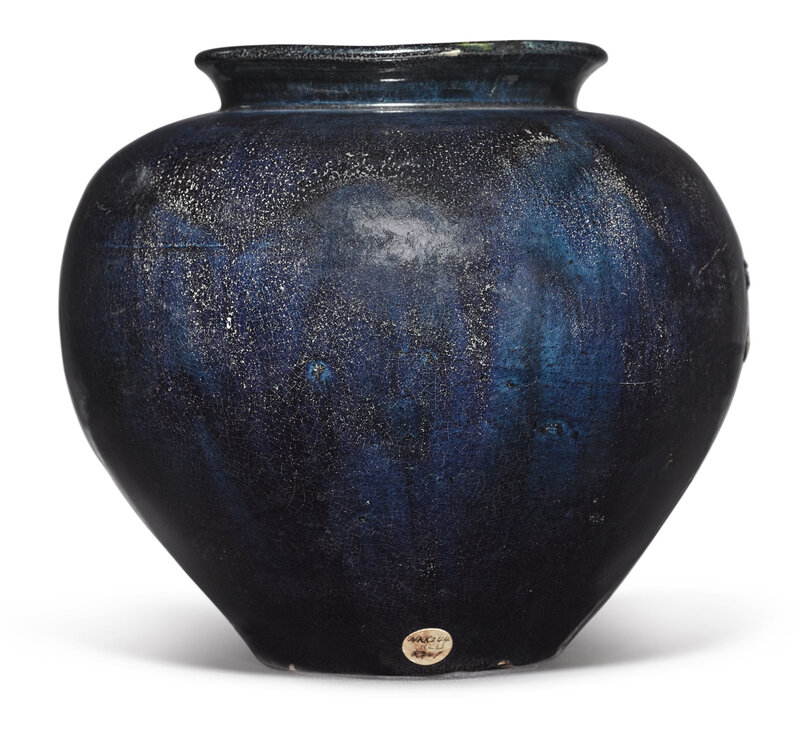
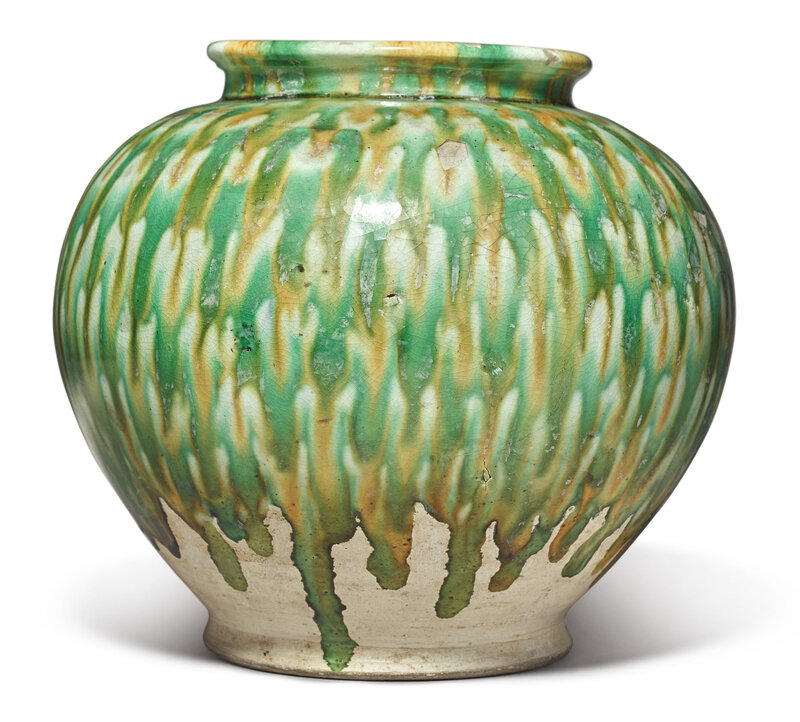
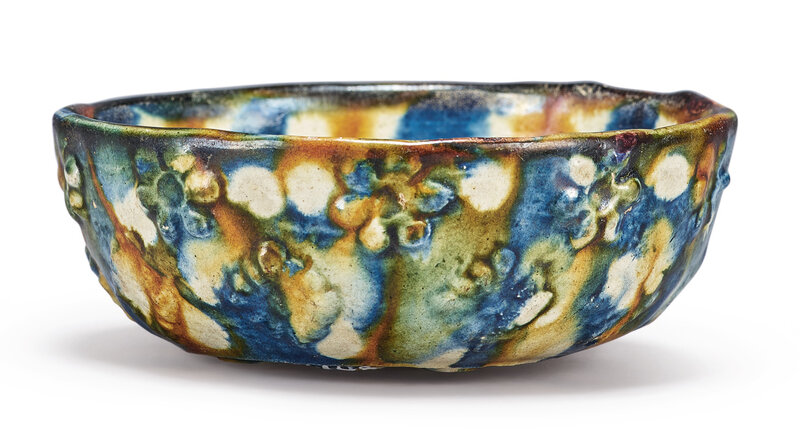





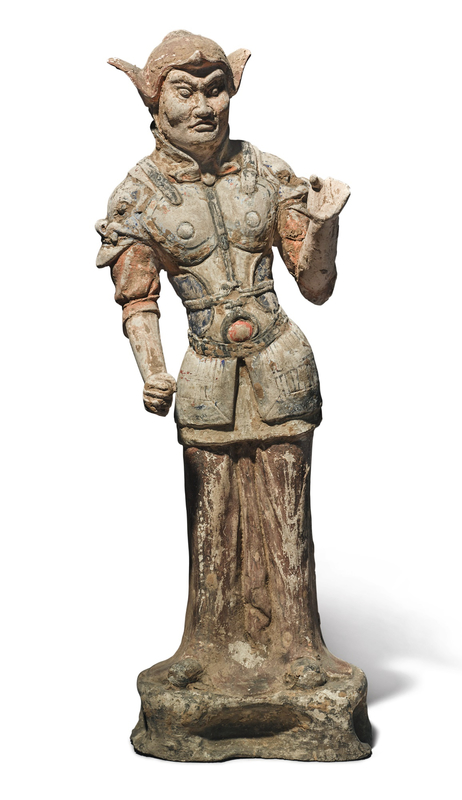




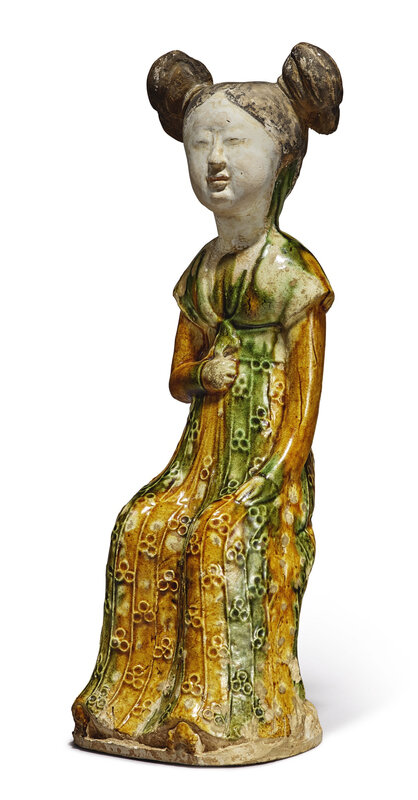
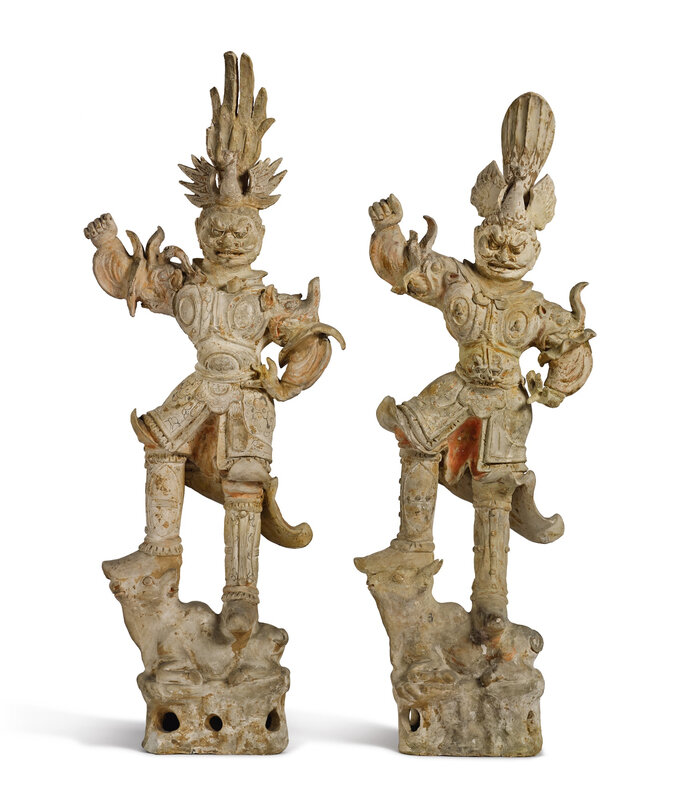






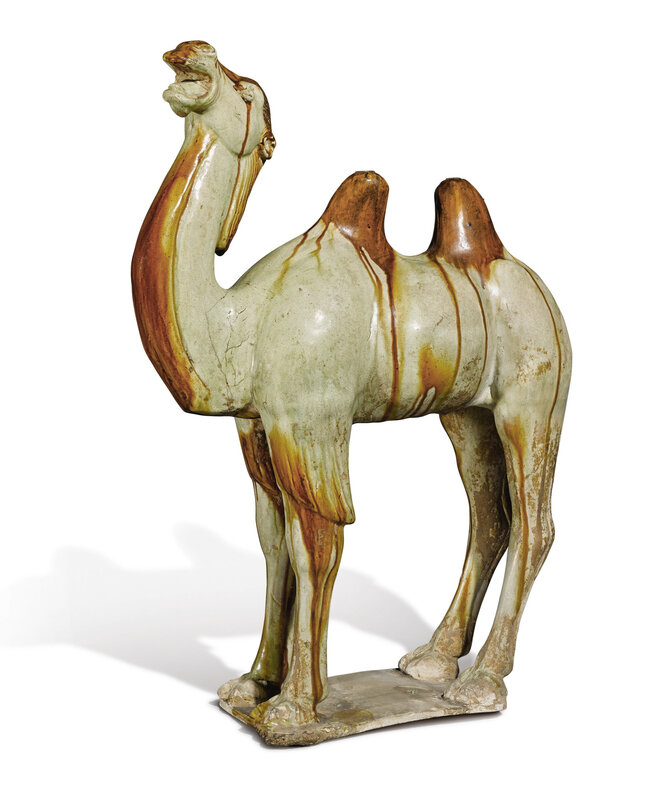
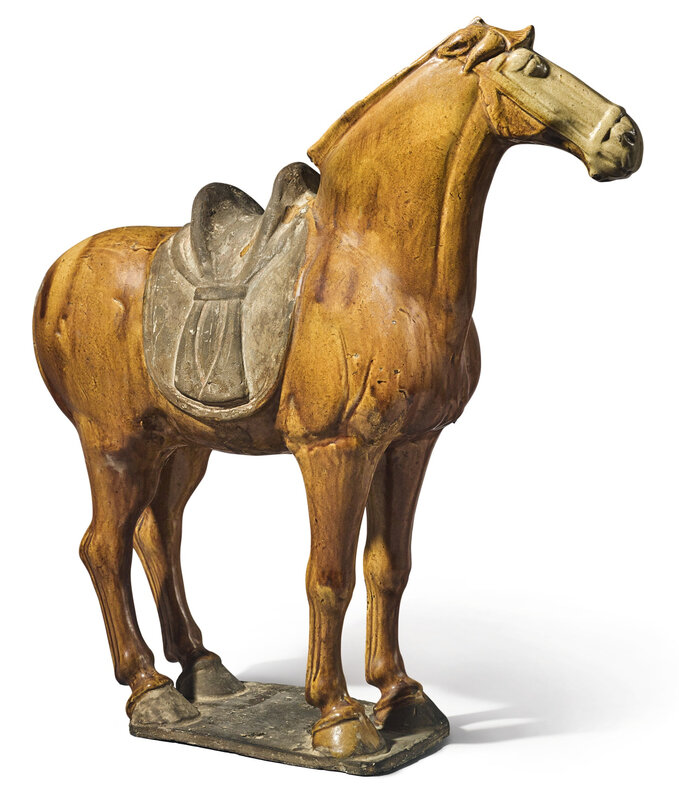



/http%3A%2F%2Fstorage.canalblog.com%2F43%2F82%2F119589%2F129801198_o.png)
/http%3A%2F%2Fstorage.canalblog.com%2F08%2F61%2F119589%2F129498117_o.jpg)
/http%3A%2F%2Fstorage.canalblog.com%2F04%2F37%2F119589%2F129467550_o.jpg)
/http%3A%2F%2Fstorage.canalblog.com%2F73%2F51%2F119589%2F129360358_o.jpg)